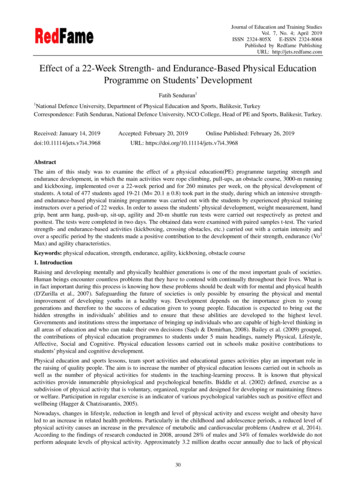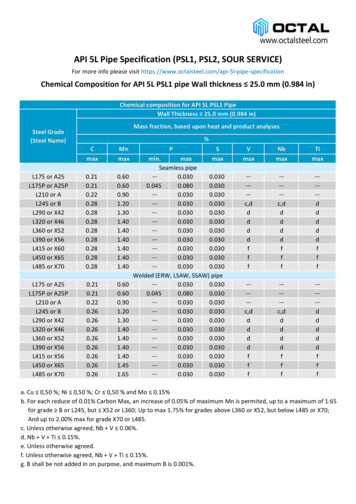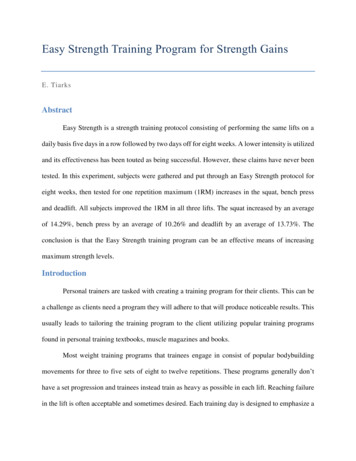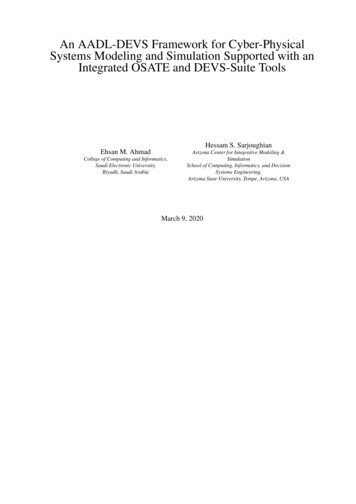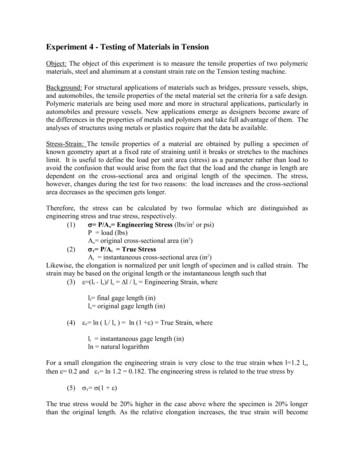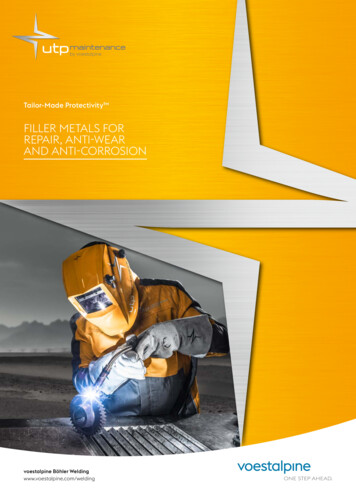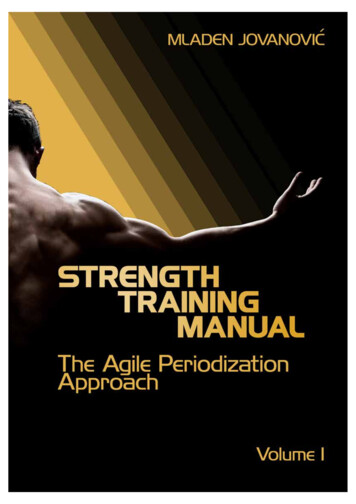
Transcription
Strength Training ManualThe Agile Periodization ApproachVolume OneMladen JovanovićPublished by:Complementary TrainingBelgrade, Serbia2019For information: www.complementarytraining.net2
Jovanović, M.Strength Training Manual. The Agile Periodization Approach. Volume OneISBN: 978-86-900803-1-1978-86-900803-2-8 (Volume One)Copyright 2019 Mladen JovanovićCover design by Ricardo MarinoCover image used under license from Shutterstock.comE-Book design by Goran SmiljanićAll rights reserved. This book or any portion thereof may not be reproduced or used inany manner whatsoever without the express written permission of the author exceptfor the use of brief quotations in a book review.Published in Belgrade, SerbiaFirst E-Book EditionComplementary TrainingWebsite: www.complementarytraining.net3
Table of ContentsPreface to the Volume One . . . . . . . . . . . . . . . . . . . . . . . . . . . . 91 Introduction . . . . . . . . . . . . . . . . . . . . . . . . . . . . . . . . . 10Precision versus Significance . . . . . . . . . . . . . . . . . . . . . . . . . 10Generalizations, Priors, and Bayesian updating . . . . . . . . . . . . . . . . 11Large and Small Worlds . . . . . . . . . . . . . . . . . . . . . . . . . . . 12Different prediction errors and accompanying costs . . . . . . . . . . . . . 13Classification, Categorization and Fuzzy borders . . . . . . . . . . . . . . . 15Place of Things vs Forum for Action . . . . . . . . . . . . . . . . . . . . . 16Qualities, Ontology, Phenomenology, Complexity, Causality . . . . . . . . . 17Philosophical stance(s) and influential persons . . . . . . . . . . . . . . . . 19What is covered in this manual? . . . . . . . . . . . . . . . . . . . . . . . 192 Agile Periodization and Philosophy of Training . . . . . . . . . . . . . . . . .21Iterative Planning . . . . . . . . . . . . . . . . . . . . . . . . . . . . . . 21Top-Down vs. Bottom-Up . . . . . . . . . . . . . . . . . . . . . . . . . . 23Phases of strength training planning . . . . . . . . . . . . . . . . . . . . .25Qualities, Methods, and Objectives . . . . . . . . . . . . . . . . . . . . . .26Dan John's Four Training Quadrants . . . . . . . . . . . . . . . . . . . . . 31Goals Setting and Decision Making (in Complexity and Uncertainty) . . . . . 33OKRs . . . . . . . . . . . . . . . . . . . . . . . . . . . . . . . . . 37Designing MVP . . . . . . . . . . . . . . . . . . . . . . . . . . . .38Is/Ought Gap and Hero’s Journey . . . . . . . . . . . . . . . . . . . . . .38Evidence-based mumbo jumbo . . . . . . . . . . . . . . . . . . . . . . . 41Certainty, Risk, and Uncertainty . . . . . . . . . . . . . . . . . . . . . . .424
Optimal versus Robust . . . . . . . . . . . . . . . . . . . . . . . . . . . 44Positive and Negative knowledge . . . . . . . . . . . . . . . . . . . . . . 46Barbell Strategy . . . . . . . . . . . . . . . . . . . . . . . . . . . . . . .47Randomization . . . . . . . . . . . . . . . . . . . . . . . . . . . . . . . 49Latent vs. Observed. . . . . . . . . . . . . . . . . . . . . . . . . . . . . .50Inter-Individual vs. Intra-Individual . . . . . . . . . . . . . . . . . . . . .54Substance vs. Form . . . . . . . . . . . . . . . . . . . . . . . . . . . . .57Other complementary pairs . . . . . . . . . . . . . . . . . . . . . . . . .59Explore – Exploit . . . . . . . . . . . . . . . . . . . . . . . . . . .59Growing - Pruning . . . . . . . . . . . . . . . . . . . . . . . . . . 60Develop – Express . . . . . . . . . . . . . . . . . . . . . . . . . . . 61Maintain – Disrupt . . . . . . . . . . . . . . . . . . . . . . . . . . 61Structure - Function . . . . . . . . . . . . . . . . . . . . . . . . . .63Weaknesses – Strengths . . . . . . . . . . . . . . . . . . . . . . . .63The Function of Muscles in the Human Body . . . . . . . . . . . . . . . . 66Grand Unified Theory . . . . . . . . . . . . . . . . . . . . . . . . . . . .70Shu-Ha-Ri and Bruce Lee’s punch . . . . . . . . . . . . . . . . . . . . . . 71Summary . . . . . . . . . . . . . . . . . . . . . . . . . . . . . . . . . .723 Exercises . . . . . . . . . . . . . . . . . . . . . . . . . . . . . . . . . . . 73General vs. Specific . . . . . . . . . . . . . . . . . . . . . . . . . . . . . .74Grinding vs. Ballistic . . . . . . . . . . . . . . . . . . . . . . . . . . . . .77Grinding movements . . . . . . . . . . . . . . . . . . . . . . . . .78Ballistic movements . . . . . . . . . . . . . . . . . . . . . . . . . .79Control movements . . . . . . . . . . . . . . . . . . . . . . . . . .79Simple vs. Complex . . . . . . . . . . . . . . . . . . . . . . . . . . . . .79Fundamental movement patterns . . . . . . . . . . . . . . . . . . . . . . 81Grinding movement patterns . . . . . . . . . . . . . . . . . . . . .83Ballistic movement patterns . . . . . . . . . . . . . . . . . . . . . .85Combining movement patterns with the Time-Complexity quadrants 86Exercise Priority/Emphasis/Importance . . . . . . . . . . . . . . . . . . .87Session Position . . . . . . . . . . . . . . . . . . . . . . . . . . . . . . 89Use of the Slots and Combinatorics . . . . . . . . . . . . . . . . . . . . . 90The use of Functional Units in Team Sessions . . . . . . . . . . . . . . . .921RM relationships . . . . . . . . . . . . . . . . . . . . . . . . . . . . . 945
Upper Body . . . . . . . . . . . . . . . . . . . . . . . . . . . . . 96Lower Body . . . . . . . . . . . . . . . . . . . . . . . . . . . . . 98Combined . . . . . . . . . . . . . . . . . . . . . . . . . . . . . . 99What should you do next? . . . . . . . . . . . . . . . . . . . . . . . . . 1004 Prescription . . . . . . . . . . . . . . . . . . . . . . . . . . . . . . . . . 103Three components of Intensity (Load, Intent, Exertion) . . . . . . . . . . 103Load-Max Reps Table . . . . . . . . . . . . . . . . . . . . . . . . . . . 106Load-Exertion Table . . . . . . . . . . . . . . . . . . . . . . . . . . . . 108Not all training maximums are created equal . . . . . . . . . . . . . . . . 111Purpose of 1RM or EDM . . . . . . . . . . . . . . . . . . . . . . . . . . 113How to estimate 1RM or EDM? . . . . . . . . . . . . . . . . . . . . . . . 115True 1RM test . . . . . . . . . . . . . . . . . . . . . . . . . . . . 115Reps to (technical) failure . . . . . . . . . . . . . . . . . . . . . . 117Velocity based estimates . . . . . . . . . . . . . . . . . . . . . . . 118Estimation through iteration. . . . . . . . . . . . . . . . . . . . . 121Total System Load vs. External Load? . . . . . . . . . . . . . . . . . . . . 125Comparing individuals . . . . . . . . . . . . . . . . . . . . . . . . . . . 134Simple ratio (relative strength) . . . . . . . . . . . . . . . . . . . 134Allometric scaling . . . . . . . . . . . . . . . . . . . . . . . . . . 135Percent-based approach to prescribing training loads . . . . . . . . . . . 137Prescribing using open sets . . . . . . . . . . . . . . . . . . . . . 138Prescribing using %1RM approach(percent-based bread and butter method) . . . . . . . . . . . . . . 139Prescribing using subjective indicators of exertion levels (RPE, RIR) . 140Prescribing using Velocity Based Training (VBT) . . . . . . . . . . . 141Other prescription methods . . . . . . . . . . . . . . . . . . . . . 142Modifications of the percent-based approach . . . . . . . . . . . . 142Rep Zones . . . . . . . . . . . . . . . . . . . . . . . . . . . . 142Load Zones . . . . . . . . . . . . . . . . . . . . . . . . . . . . 143Subjective Indicators . . . . . . . . . . . . . . . . . . . . . . . 145Velocity Based Training. . . . . . . . . . . . . . . . . . . . . . 146Time and Reps Constraints . . . . . . . . . . . . . . . . . . . . 147Prediction and monitoring . . . . . . . . . . . . . . . . . . . . . . . . . 148Ballistic Movements . . . . . . . . . . . . . . . . . . . . . . . . . . . . 1586
What is 1RM with ballistic movements . . . . . . . . . . . . . . . . . . . 159What is failure with ballistic movements (and how many reps to do) . . . . 162Appendix: Exercise List . . . . . . . . . . . . . . . . . . . . . . . . . . . . . 167References . . . . . . . . . . . . . . . . . . . . . . . . . . . . . . . . . . . 171About. . . . . . . . . . . . . . . . . . . . . . . . . . . . . . . . . . . . . . 1857
STRENGTH TRAINING MANUAL Volume OnePreface to the Volume OneWhen I started writing the Strength Training Manual, I wanted it to be a simpleand short book with heuristics and reference tables. As I began to write, I soon realizedthat the readers will have hard time understanding how to actually apply those heuristicsand tables, as well as understand the whys behind them. Additionally, writing is not asimple act of dumping material on paper for me, but rather an act of exploration anddiscovery. Therefore, as I wrote, new things emerged and I wanted to play with them,attack them from multiple perspectives to see how robust they are. In the end, this madethe Strength Training Manual much larger and much slower to write than I originallyintended.The reasons why the Strength Training Manual e-book comes in volumes areas follows. First, I can split it in chunks, which, for those who embark on any writingadventure, is much more manageable. Second, I wanted this to be available to thereaders as soon as possible, so that I can collect the feedback and improve the text for thepotential paperback/hardback edition. Third, reading 600-page e-book is much harderthan reading 200-something e-book. Fourth, the profit. E-book version of the StrengthTraining Manual published in volumes is available for free for the ComplementaryTraining members, which makes it an additional benefit of the membership. In anutshell, publishing in volumes seemed like a good idea and a solution. Only time willtell if I was right or wrong.In this Volume One, first four chapters are published, plus the exercise table fromthe Appendix. This Volume is heavier on the philosophy and the Agile Periodizationbehind my strength training planning, although chapters 3 and 4 are much morepractical and provide multiple useful tables and heuristics.As always, I am looking forward to your critiques and feedback. Please do nothesitate to contact me if you have any questions or spot any kind of bullshit.Mladen Jovanović8
MLADEN JOVANOVIĆ1 IntroductionAs a strength and conditioning coach, I have always collected and referencednumerous tables, heuristics and guidelines (such as various rep max tables, Prilepintable, exercise max ratios to name a few) that helped me create strength trainingprograms. Unfortunately, these were usually spread all over the place: numerous booksand papers, countless Excel sheets and PowerPoint presentations. Every time I wantedto quickly find something to reference and possibly to compare, it was a major pain inthe arse finding it. So I decided to put them all together in one place, where I can easilyfind them and use them, possibly have it at arms reach in the gym.Thus, I decided to create this manual. But please note that this manual is not anin-depth how-to book, but a simple collection of useful tables and heuristics that youcan use as a starting point when designing your strength training programs. Havingsaid this, it is important to quickly go through some of the rationale and warningsbefore diving into the material. It is a bit philosophical, but please bear with me for thenext few pages.Precision versus Significance“As complexity rises, precise statements lose meaning and meaningful statements loseprecision” - Lofti ZadehThe material in this manual is WRONG. It is not precise. It will vary, sometimesa lot, between exercises, individuals, and genders (all 457 of them). This should beexpected since day-to-day motivation and readiness to train, improvement rates,testing errors, among others, are not constant and predictable, but rather representsources of uncertainty, often experienced when working with athletes or dealing with9
STRENGTH TRAINING MANUAL Volume Oneany kind of performance enhancement. It is therefore up to you to update it with theinformation you possess and gain through training iterations. Figure 1.1 below depictsperfectly the difference between precision and significance, and the aim of this manual.Figure 1.1. Difference between precision and significance. Image modifiedbased on image in Fuzzy Logic Toolbox User’s Guide (MathWorks, 2019)Generalizations, Priors,and Bayesian updatingNot sure if there is anything else that pisses me off more than hearing someonesay: “You cannot generalize!”. Yeah right, I will approach every phenomenon in theUniverse as unique and genuine. Not sure we have the brain power for that - that’s whywe try to reduce the amount of information by generalizing. There is no science withoutgeneralization. That’s why we have generalizations, laws, archetypes, stereotypes.But smart people are not slaves to generalizations - they start with generalizations,but quickly update them with new information to improve their insights. For example,one can say that females are generally weaker than males (yeah, sexist generalization),which means two things: (1) average female is weaker than the average male, and (2)randomly selected female will be very likely to be weaker than randomly selected malein the population. Of course, we also need to take into account how much weaker, butwithout making this a statistic treatise about magnitudes of effects, one cannot claimthat all females are weaker than all males. Even if we start with this generalization beforeworking with a new female individual client or athlete and assume generalization is true10
MLADEN JOVANOVIĆand we apply it to this individual as well (let’s call this prior belief), we need to updatethis prior belief with observations and experience while working with this individual,who might be a future or current world class powerlifter (and probably stronger than90% of males).This means that we need to update our prior beliefs (e.g. generalizations, orheuristics) with our own observations in the process called Bayesian updating to gaininsights which will educate our decision making.PriorInsightObserva onsFigure 1.2. Bayesian updating, simplifiedThis manual is full of generalizations. Hence, you need to look at them as astarting point, which you should update with your own observations, experience,experimentations, and intuition. Just don’t be a dumbfuck and blindly believe and adopteverything that has been written. Again, use it as a starting point (prior).Large and Small WorldsThe real world is very complex and uncertain. To help in orienting ourselves in it,we create maps and models. These are representations of reality, or representations ofthe real world. In the outstanding statistics book “Statistical Rethinking” (McElreath,2015), author uses an analogy, originally coined by Leonard Savage (Savage, 1972;Binmore, 2011; Volz & Gigerenzer, 2012; Gigerenzer, Hertwig & Pachur, 2015a), thatdifferentiates between Large World and Small Worlds:“The small world is the self-contained, logical world of the model. Withinthe small world, all possibilities are nominated. There are no pure surprises, like11
STRENGTH TRAINING MANUAL Volume Onethe existence of a huge continent between Europe and Asia. Within the smallworld of the model, it is important to be able to verify the model’s logic, makingsure that it performs as expected under favorable assumptions. Bayesianmodels have some advantages in this regard, as they have reasonable claimsto optimality: No alternative model could make better use of the information inthe data and support better decisions, assuming the small world is an accuratedescription of the real world.The large world is the broader context in which one deploys a model.In the large world, there may be events that were not imagined in the smallworld. Moreover, the model is always an incomplete representation of thelarge world and so will make mistakes, even if all kinds of events have beenproperly nominated. The logical consistency of a model in the small world is noguarantee that it will be optimal in the large world. But it is certainly a warmcomfort.”1Everything written in this manual represents Small Worlds - self-containedmodels of assumptions about how things work or should work. Although they are allwrong, some of them are useful2 (to quote George Box), especially as a starting point inyour orientation, experimentation, and deployment to the Large World. It is importantto remember the distinction between the two. I embrace the integrative pluralism(Mitchell, 2002, 2012) in a way that there are multiple models (Page, 2018) that weshould use to explain, predict and plan intervention in the Large World.Different prediction errorsand accompanying costsSince all models are wrong, but some are useful, we need to make sure they don’tcome with harmful errors and potential costs. We can make different types of errors,and they come at different costs. Let’s take a simplistic model of predicting 1RM (onerepetition maximum, or maximal weight one can lift with a proper technique):Table 1.1 represents a common scenario for predicting 1RM. The top row containstwo TRUE values (150kg and 180kg) and on the side, we have two predictions. Thegrey diagonal represents correct predictions, while red diagonal represents erroneouspredictions. Type I is undershooting (predicting 150kg when the real value is 180kg),1 Excerpt taken from “Statistical Rethinking” (McElreath, 2015), page 192 “All models are wrong, but some are useful” is aphorism that is generally attributed to the statisticianGeorge Box. Nassim Nicholas Taleb expanded this aphorism to “All models are wrong, many are useful,some are deadly”12
MLADEN JOVANOVIĆand Type II is overshooting (predicting 180kg when the real value is 150kg). Doesmaking these two errors come with different costs if the predicted 1RM is implementedinto the training program? Hell yes!150 kg180 kg150kgCorrectError I(undershoo ng)180kgPredicted 1RMReal 1RMError II(overshoo ng)CorrectTable 1.1. Different types of prediction errorIt must be noted that undershooting a lot is still safer than overshooting a little.This is because when you undershoot, you can still perform training sessions andeasily update, while if you overshoot, you will hit the wall quite quickly, and potentiallyinjure someone or create expectation stress and/or heavy soreness. Plus, in my ownexperience, it is easier to ask for more from an athlete, than less. Furthermore, imaginethat your program calls for 3 sets of 5 reps with 100kg, and your athlete feels great andperforms 8 reps in the last set instead of the situation where your program calls for 3sets of 5 with 110kg and the athlete struggles to finish it, or might even need to stripthe weights down. Performing better than it has been written in the training programis always motivational (first situation), whereas the opposite can be very discouraging(second situation). Collectively, this approach represents protection from the downside(i.e. injury) which can further allow us to invest in the upside (i.e. strength trainingadaptation). But more about this in the next chapter.The problem is that we cannot get rid of errors - we can balance them out byaccepting higher Type I error while minimizing Type II error, or vice versa. In thismanual I accepted the fact that when making errors (and I do make them), I want themto be Type I errors, or undershooting errors since they come up with much less cost thatcan easily be fixed through few training iterations. Because of that, you might noticethat some percentages in this manual are quite low. Therefore, I suggest you take asimilar philosophy when deciding about percentages and every other guideline in thismanual: lean on the side of conservatism and safety first.13
STRENGTH TRAINING MANUAL Volume OneClassification, Categorizationand Fuzzy bordersAs it is the case with generalization, classifications and categorizations (whichI consider synonyms here and use interchangeably) are aiming to reduce the numberof dimensions and numbers of particular phenomena at hand (with the aim of easierorientation and action). This eventually means that items in one bracket or class mightdiffer, while items from different brackets or classes might be similar. Besides, thereare multiple approaches to classifying phenomena which might have different depthsor levels of precision (see Figure 1.3). To paraphrase Jordan B. Peterson: “Categoriesare constructed in relationship to their functional significance”, meaning there are noobjective or unbiased approaches to categorization and classification, and they dependon how we aim to use those categorizations3. For example, powerlifter might classifystrength training means, methods, qualities, and objectives differently than Olympicweightlifter or a soccer player. This is because they experience different phenomenaand demand a different forum for action. But if you ask your average lab coat to performunbiased and objective classification, he or she will usually perform it as a place of thingstype of classification.Categorization is not an exercise in futility, but rather helps us make betterdecisions (more educated and faster decisions via information reduction andsimplification). This simplification has some similarities with heuristics (fast andfrugal rules of thumb that help to avoid overfitting in a complex and uncertain world).Hence, categories should have functional significance. In other words, you want to usethose categories somehow. Therefore, one should stop categorizing once there is nofunctional significance.That said, categories should be in the lowest possible “compression” (lowestresolution) that still conveys enough pragmatic information. Since there are numerousways to categorize certain items (see Kant’s thing in itself4), the way we approachcategorization and what we see, depends on what we plan using it for (see Figure 1.3). Imight be wrong, but this reminds me of both phenomenology5 (things as they manifest3 Also check essentialism versus nominalism, realism versus instrumentalism/constructivism and howthey are integrated with pragmatist-realist position (Borsboom, Mellenbergh & van Heerden, 2003;Guyon, Falissard & Kop, 2017)4 From Wikipedia (“Thing-in-itself,” 2019): “The thing-in-itself (German: Ding an sich) is a conceptintroduced by Immanuel Kant. Things-in-themselves would be objects as they are, independent ofobservation”5 From Stanford Encyclopedia of Philosophy (Smith, 2018): “Literally, phenomenology is the study of“phenomena”: appearances of things, or things as they appear in our experience, or the ways we experiencethings, thus the meanings things have in our experience. Phenomenology studies conscious experience asexperienced from the subjective or first-person point of view.”14
MLADEN JOVANOVIĆto us) and pragmatism6 (practical application), although they are radically opposedphilosophical positions (together with analytic philosophy, which can be consideredyour average lab coat objective and unbiased approach to classification). It is beyondthis manual (and my current knowledge) to discuss these topics, but in my opinion,philosophy is very much alive, and it needs to be taken into account especially with therecent rise of scientism7 in sport science and performance."Thing in itself"Classi ca on 1Classi ca on 2Classi ca on 3Classi ca on 4Classi ca on 5Figure 1.3. There is no bias-free, objective way to classify phenomena.Classification depends on what you plan to use it for8Place of Things vs Forum for ActionClassification thus serves a dual purpose: place of things and forum for action.By term place of things, I refer to simply classify phenomena relative to some objectivecriteria (this is usually physiological, anatomical or biomechanical criteria), or usingan analytical approach. On the other hand, the forum for action refers to a classificationbased on how we intend to use these classes in planning, action, and intervening.In this manual, I am leaning more toward forum for action approach in classifyingphenomena, mostly as strength and conditioning coach of team sports athletes, ratherthan powerlifting or a weightlifting coach. This doesn’t mean that powerlifting andweightlifting coaches cannot use this manual (at the end of the day, we have common6 From Stanford Encyclopedia of Philosophy (Legg & Hookway, 2019): “Pragmatism is a philosophicaltradition that – very broadly – understands knowing the world as inseparable from agency within it.”7 Belief or stance that all things can be reduced to science (Boudry & Pigliucci, 2017)8 Thing-in-itself: "What do you see? Depends on what do you want to use it for". Modified based on theimage from Maps of Meaning 5: Story and Meta-story course by Jordan B. Peterson (Peterson, 2017)15
STRENGTH TRAINING MANUAL Volume Onephysiology, anatomy, psychology, and experience shared phenomena in training), butthat they might classify things a bit differently because their forum for action differsthan the forum for action of the non-strength-sport athletes.It is also important to mention that class membership is not a TRUE/FALSE state(although it does simplify things a lot), but rather fuzzy (or continuous) membership.For example, is split squat double leg or single leg movement? For simplicity (SmallWorld model) it is easier to assume it belongs only to one class or category, but in reallife (Large World) we know it is not that easy to make a hard border between classes(thus, it can be 60% double leg, and 40% single leg, or what have you). One helpfulapproach, that helps me at least in minimizing how much I break my own balls overcategorization, is to ask “How do I plan using this classification and for whom?”. Also,remember that you do not need to be very precise, but rather meaningful and significantin helping yourself orienting from the forum for action perspective (see Figure 1.1).Qualities, Ontology, Phenomenology,Complexity, CausalityMost, if not all, coaching education material regarding planning and periodizationcomes with highly biased classification using objective physiological and biomechanicalapproaches (place of things; analytical approach (Loland, 1992; Jovanovic, 2018)). Thesefields have a monopoly on defining ontology9 (“What exists out there”) of qualities andmethods: maximal strength, explosive strength, VO2max, anaerobic capacity, youname it. Some individuals tend to wave around with this scientific method, as somethingobjective and unbiased, but they are just value signaling, because they are using ascientific approach, and you, the little dungeon dweller, are not. But unfortunately,there is no objective or unbiased approach, and you, the dungeon dweller, might engagephenomena classification as you experience it (phenomenology) and you should not beembarrassed about your subjectivity. Yes, you should understand anatomy, physiologyand biomechanics, but they should not hold the monopoly over how you classify thephenomena of importance to you. They are necessary, but not sufficient knowledge.Since these fields define what is real (ontology), it is natural to follow up withan approach that assumes these qualities as the building blocks of periodized training9 From Wikipedia (“Ontology,” 2019): “Ontology is the philosophical study of being. More broadly, itstudies concepts that directly relate to being, in particular becoming, existence, reality, as well as the basiccategories of being and their relations. Traditionally listed as a part of the major branch of philosophyknown as metaphysics, ontology often deals with questions concerning what entities exist or may be saidto exist and how such entities may be grouped, related within a hierarchy, and subdivided according tosimilarities and differences.”16
MLADEN JOVANOVIĆprograms. Beyond this, we assume very simplistic causal models (Small World modelsof what causes what), where we further assume there is some magic training method, orintensity zone, that drives adaptation of the qualities we need to address. For example,we might claim that reps 90% improve maximal strength and that reps with 65% donefast improve explosiveness. This is bullshit. Even worse than this is the Load Velocitycurve with associated qualities and intensity zones.Unfortunately, or luckily, things are not that simple. Yes, we can use these asSmall World models, representations and heuristics (which they are), rather than thefactual state of the world (ontology). First, different individuals will manifest differentphenomena and will demand different quality identification as a forum for action.For example, what is holding back a world-class powerlifter in the bench press of200kg might be lockout strength or bottom strength (and these are phenomenologicalqualities). Thus, one might approach intervention with these qualities in mind. Thiswill not be the case for your average soccer player since his bench press performance isnot the ultimate goal, but rather one aspect of what we might consider important forhim (i.e. horizontal pressing). Biomechanically speaking, they are identical (place ofthings), but phenomenologically, they are very much different, especially in definingthe qualities from the forum for action perspective and deciding about intervention toimprove them.MethodsRepeated E ortMethodRepeated E ortMethodMax E ortMethodDynamic E ortMethod( 65% 1RM)(75-85% 1RM)( 90% 1RM)(50-60% 1RM)Complexes,WODs, CircuitTrainingAnatomicAdapta onHypertrophyMaximalStrengthRate of ForceDevelopmentStrengthEndurancei sFigure 1.4. An overly simplistic causal model of methods and qualities17
STRENGTH TRAINING MANUAL Volume OneSecond, assuming there is an associated training method or intensity zone thatmagically hits identified quality is a pipe dream. The causal network is very complex andat the end of the day, we do need to realize and accept the fact that we are experimentingusing a case-by-case approach. There are still useful priors we can rely on (e.g.scientific studies, best practices, ol
the Strength Training Manual much larger and much slower to write than I originally intended. The reasons why the Strength Training Manual e-book comes in volumes are as follows. First, I can split it in chunks, which, for those who embark on any writing adventure, is much more

